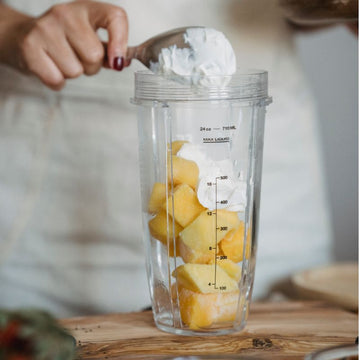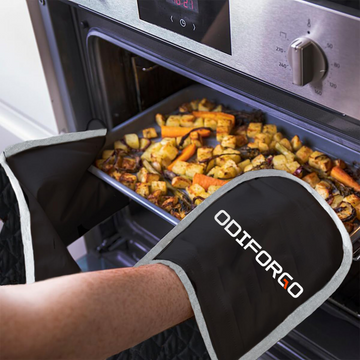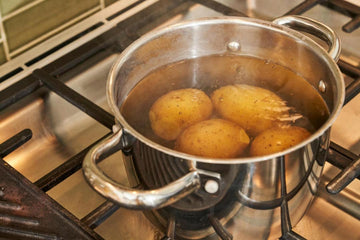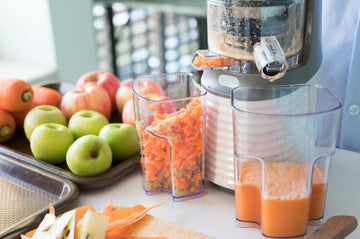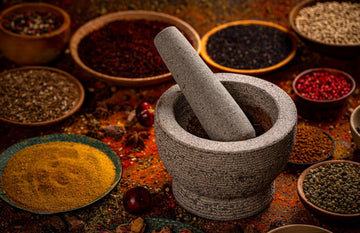Mashed potatoes seem simple: just potatoes, a bit of fat, and some seasoning. But the way you mash them determines whether the result is creamy, rustic, or somewhere in between. Using a masher or a ricer keeps the process easy, yet small choices like how the potatoes are boiled, when butter or milk is added, and how firmly you press can completely change the texture.
What is a potato masher or ricer
A potato masher is a simple handheld tool with a grid or wave-shaped plate at the end, designed to press down and break potatoes into small, fluffy pieces. A ricer looks more like a large garlic press, squeezing the potatoes through small holes to create an extra-smooth texture. Both tools are made for the same purpose, but they give different results: the masher produces a more rustic mash with tiny chunks, while the ricer creates an airy, uniform consistency.
If you already own one, the process is straightforward. Boil your potatoes until tender, drain them well, and press down with the masher or load them into the ricer. Work in batches and don’t over-mash, as this can turn the potatoes gluey. From there, you can mix in butter, cream, or any other seasoning you prefer.
Different ways to mash potatoes without a masher
Not having a potato masher doesn’t mean you have to give up on creamy, fluffy mashed potatoes. In fact, there are several tools—both manual and electric—that can help you get the job done. Each method creates a slightly different texture, so the choice depends on whether you like your mash rustic, smooth, or somewhere in between.

Using a fork
The simplest and most common alternative is the fork. Once your potatoes are fully boiled and tender, drain them well and return them to a warm pot. Use the flat underside of a sturdy fork to press down on the potato chunks, breaking them apart bit by bit. Dragging the fork across the potatoes helps smooth them out, while turning them over and repeating the process reduces lumps. A fork creates a more rustic, slightly chunky mash, but it’s perfectly satisfying and works best for small batches.
Using a whisk
A balloon whisk can do more than beat eggs—it’s also a handy tool for potatoes. After cooking and draining, press the whisk down into the potatoes, twisting slightly to break them apart. Continue pressing and stirring until they’re smooth. The curved wires of the whisk help aerate the potatoes, creating a lighter texture. This method requires a bit of elbow grease, but it delivers surprisingly creamy results without any special equipment.
Using a spoon
If you want control over the texture, a wooden spoon is a reliable choice. Simply stir and press the spoon into the potatoes against the side of the pot. The back of the spoon works like a small makeshift masher, while vigorous stirring helps smooth everything out. A wooden spoon tends to leave the mash a little denser than a fork or whisk, which some people actually prefer.
Using a hand mixer
For larger batches, an electric hand mixer is a lifesaver. Add your cooked potatoes back into the pot, then use the beaters on a low to medium setting. Start slowly to avoid splattering, then increase the speed as the potatoes break down. Hand mixers create a fluffy, whipped texture, but be careful not to overmix—the starch can turn gummy if the potatoes are beaten too much.
Using a stand mixer
If you already have a stand mixer on your counter, it can handle the job with little effort. Add the drained potatoes to the mixing bowl, attach the paddle (not the whisk), and beat on a low speed until smooth. This method is efficient, especially for holiday cooking or big family dinners, though the results lean toward very smooth and creamy. Like the hand mixer, overbeating can make the mash gluey, so watch the texture closely.
Using a blender
Blenders are powerful enough to break down potatoes into a silky puree, but this comes with a risk. Too much blending releases excess starch, making the texture unpleasantly sticky. If you use this method, pulse in short bursts and stop as soon as the potatoes look smooth. This approach works better if you’re intentionally going for a very silky, almost restaurant-style puree rather than traditional mashed potatoes.
Using a grater
This one is a bit unconventional but works surprisingly well. Take a box grater and carefully grate the cooked, soft potatoes. The fine holes on the grater break the potatoes down into small, fluffy shreds, which you can then stir together into a smooth mash. This method requires care to avoid burning your fingers, but it produces a delicate, light texture.
Using a rolling pin
For large batches when you don’t have any kitchen gadgets, a rolling pin can step in. Place the cooked potatoes in a sturdy plastic bag (like a freezer bag), seal it, and gently roll the pin back and forth until the potatoes are broken down. Empty the bag into a bowl and stir to finish. This method is neat, keeps cleanup simple, and avoids potato bits flying around the kitchen.
Using your hands
As a last resort, clean hands can get the job done. Once the potatoes are cool enough to handle, squeeze and crush them with your fingers until they reach the consistency you want. While it won’t produce a restaurant-style mash, it’s a practical, no-tool solution in a pinch. Just make sure your hands are squeaky clean before diving in.
Tips and hacks to make a perfect potato mash

Getting the perfect mashed potatoes isn’t just about the tool you use; it’s about technique, timing, and a few tricks that can take a basic mash from ordinary to exceptional. One of the most important factors is starting with the right type of potato. Starchy potatoes like Russets break down easily and yield fluffy mash, while waxy varieties like Yukon Golds hold their shape better and create a creamier, denser texture. Some cooks even blend the two types to balance fluffiness and creaminess.
How you cook the potatoes also matters. Boil them evenly, cut into uniform chunks, and cook until just tender. Overcooking can make the potatoes waterlogged, which will dilute the flavor and make it harder to get a creamy texture. After draining, return the potatoes to the pot and let them sit over low heat for a minute or two to evaporate excess moisture. This step helps create a richer, less watery mash.
When it comes to making the potatoes creamy, the fat and liquid you add are key. Warm butter and milk or cream incorporate more smoothly than cold ingredients, ensuring the mash stays fluffy rather than gummy. Adding them gradually allows the potatoes to absorb the liquid evenly. Some cooks like to mix in a little sour cream, cream cheese, or even yogurt for extra richness and a subtle tang. Olive oil or a touch of clarified butter can also be used if you prefer a slightly lighter mash.
Salt is another factor that can’t be overlooked. Season the potatoes while mashing, not just at the end, so the flavor is well distributed. You can also experiment with herbs and aromatics: roasted garlic, chives, parsley, or a hint of nutmeg can elevate simple mashed potatoes into a standout side dish. For those who want an ultra-smooth texture, mashing in stages or using a whisk after a first pass with a fork can make a noticeable difference.
Finally, don’t be afraid to think outside the box. Slightly unconventional techniques, like adding a spoonful of warm chicken stock for extra moisture or folding in finely grated cheese for creaminess and depth, can create unique textures and flavors. Letting the mash rest briefly before serving allows it to settle and absorb the flavors, ensuring every spoonful is balanced and delicious.
By combining the right potato, careful cooking, gradual mixing of warm fats, and a few strategic flavor boosters, you can achieve mashed potatoes that are creamy, flavorful, and perfectly textured—without ever needing a traditional masher.
Frequently asked questions
Can you freeze mashed potatoes?
Yes, mashed potatoes can be frozen, but texture and flavor may change slightly. Cool them completely, place in an airtight container or freezer bag, and freeze for up to 2–3 months. To reheat, thaw in the fridge overnight, then warm gently on the stove or in the oven, stirring in a little milk or butter to restore creaminess.
Can I make mashed potatoes without peeling them?
Absolutely. Leaving the skins on adds fiber and nutrients, and it also creates a more rustic texture. Just make sure to wash the potatoes thoroughly and remove any blemishes before boiling. Smaller potatoes or Yukon Golds work best for this method.
How do I prevent mashed potatoes from becoming gluey?
Gluey potatoes usually result from overworking the starch. Avoid using a blender or food processor unless you want a puree. Stick to mashing gently with a fork, whisk, or hand mixer on low speed, and add warm fats and liquids gradually.
Can I use alternative liquids instead of milk or cream?
Yes. Broth, stock, or even plant-based milks like oat or almond milk can be used. Warm the liquid before adding to ensure smooth incorporation and maintain a creamy texture.
How can I make my mashed potatoes extra fluffy?
Use starchy potatoes like Russets, mash in stages to avoid overworking, and fold in warm butter and milk gradually. Whisking gently at the end or folding in a small amount of whipped cream or sour cream can add extra airiness without making them heavy.
No masher? No problem
Even without a traditional potato masher, achieving creamy, flavorful mashed potatoes is entirely possible. From forks and whisks to hand mixers or even a rolling pin, there are multiple tools and techniques to suit any kitchen setup.
The key lies in cooking the potatoes evenly, handling them gently, and gradually incorporating fats and liquids to reach the perfect texture. With a few tips and a bit of patience, you can create mashed potatoes that are smooth, fluffy, and satisfying—proving that great results don’t always require specialized equipment.





